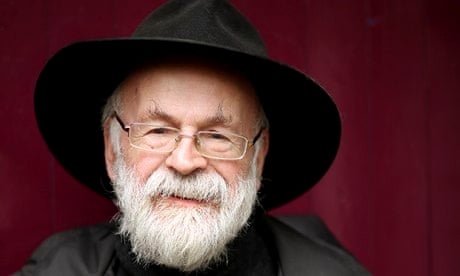I like my fantasy novels to have maps; I'm old-fashioned that way. Not coming up with one indicates a certain lack of commitment by the author to what JRR Tolkien called "the act of secondary creation". A good map of a fantasy world – like its real-world counterpart – tantalises us with the possibilities. What we might see, where we might go.
Terry Pratchett's Discworld novels have never included maps. Maps exist – you can buy poster-sized versions to hang on your wall or get them as an app for your iPad (I've done both) – but they've merely been an afterthought. Pratchett has always been adamant that the Discworld was "a place where stories happen", and that drawing a map would be too constraining. So I was a bit surprised when I opened my copy of Raising Steam, the 40th book in the series, and found a beautiful map spread across pages eight and nine.
But the inclusion of a map doesn't mean that the Discworld has finally succumbed to the iron conventions of the traditional fantasy novel. Because this is a railway map, and it marks the world's triumphant arrival into the modern era.
The series started as a satirical journey through the conventions of the fantasy genre. It painted its world in broad outline and great splashes of colour, although, from the first, the novels demonstrated Pratchett's eye for telling detail and the absurdities of the human condition. As the series progressed, a strange thing occurred – the Discworld, created as a setting for humorous stories, began to take on a certain solidity, as if it were striving to become a real place. It's a conceit that would have pleased Borges.
This process was taking place not through the deployment of the traditional fantasy map but through the replacement of archetypes with solid three-dimensional characters.This started, surprisingly, with the character of DEATH, but he was soon followed by the Witches, Lord Vetinari, Captain Vimes and the Archchancellor of the Unseen University, Mustrum Ridcully. These personalities got their feet under the table, as it were, to the point where their fictional demise would prompt national mourning and, possibly, death threats to the publisher.
Thirty years on, the Discworld has grown so solid and so weighty that any new novel has to exert a great deal of narrative power just to get that world moving at a decent pace. So it's just as well that the latest book concerns the arrival of the Discworld's very own steam locomotive.
Raising Steam tells the story of what happens when steam power is added to Ankh-Morpork's already febrile industrial revolution, with predictable results – screams, explosions and people running into the night. In response the city's ruler, the Patrician, pitches former conman Moist von Lipwig, his number one troubleshooter, into the confusion to bring, if not order, then at least some level of control. Meanwhile, conservative factions among the dwarves, fearing that this brave new world might destroy thousands of years of tradition, take violent action against the accoutrements of modernity.
The genius of Pratchett is that he never goes for the straight allegory. Yes, the arrival of steam travel parallels the development of the railways in Britain, not least in the sudden elevation of Swine Town (Swindon) into a major industrial centre, and the fact that its pioneers are a mixture of self-made entrepreneurs, northern engineers and fast-talking conmen. But it is also heavily influenced by the unique "reality" of the Discworld, including trolls, goblins and, of course, magic. Likewise, if you squint a little, the extremist factions of the dwarves could be seen as an allegory for militant Islam – but only if you ignore how they resemble evangelical Christians, or luddites, or just people who are afraid of the pace of change in the modern world. Pratchett's themes are the big ones: the threat and promise of change, the individual's search for meaning within their own society, and the fine moral judgments that have to be made between competing rights and freedoms.
If sometimes the mighty engine of Pratchett's prose skids a bit on the upslope – a tad didactic here, a little heavy-handed in its moralising there – we can forgive him. Not least because he remains one of the most consistently funny writers around; a master of the stealth simile, the time-delay pun and the deflationary three-part list (1). On the morning of its release, I could tell which of my fellow tube passengers had downloaded it to their e-readers by the bouts of spontaneous laughter. Not something you see very often during rush hour.
(1) Not to mention the strategic deployment of a well-placed footnote.

Comments (…)
Sign in or create your Guardian account to join the discussion